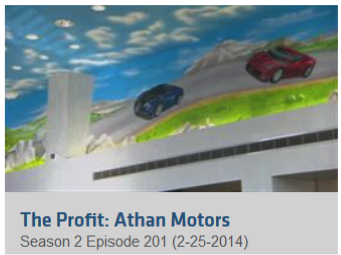Wasp Barcode Technologies: The Barcode Solution People
Wasp Welcomes Back “The Profit” for Season 2

Anyone who tuned in to the first season of “
The Profit” on CNBC should be aware of Marcus Lemonis’ 3 P’s philosophy. The core of his ideology centers on the fact that business success hinges upon the effective management of
People,
Process, and
Product. On February 25
th, “The Profit” returned for its long-awaited second season.
At Wasp, we were early-adopters of the series for a number of reasons. We recognized the challenges our customer base experiences first-hand and appreciated seeing those challenges addressed in each episode. As experts in the small business,
inventory management solutions field, we were not surprised to see a recurring theme – the inventory management process plagues small business owners.
Last season we watched Lemonis attempt, in vain (spoiler alert), to save Maarse Florist. It was no surprise that a florist, in particular, would face a number of inventory challenges. Business owners with an obviously perishable inventory, in a high-turnover environment would benefit greatly from an automated system to track incoming and outgoing stock as well as to the ability to measure historical trends.
We will continue to watch this new season of “The Profit” to see if Lemonis should adjust his 3 P’s to PIPP – People,
Inventory, Process, & Product.
Athans Motors

Season 2, Episode 1 of “The Profit” focused on a used car dealership in Morton Grove, Illinois. Inventory is the number one expense and concern of any car dealership. Turning a profit in this type of business relies upon a careful balance of inventory carrying costs. Upon arrival at Athans Motors, Lemonis immediately recognized the empty car lot.
“Can’t figure out if this place is even open, where are all the cars?” Marcus Lemonis
Pete Athans, the owner of Athans Motors, invested his business capital into creating a facility centered on the customer experience – with a lounge devoted to video games and large TVs. Additionally, the cars he did have available (which were few) were the wrong cars for the market. Rather than a large inventory of reasonably priced vehicles, Athans invested in fewer, high-sticker priced cars.
His limited and lacking inventory did not attract and often turned away customers; leaving Athans with almost $7 million dollars in debt and $150,000 in losses added every month. To address the monthly loss, Athans would need to sell at least 60 cars per month with an average profit of $2,500 per car. The key?
An appropriate level of inventory. To sell 60 cars, Athans would need at least 120 cars on his lot.
The Offer
Lemonis offered Pete Athans a deal: $3.5 million to clear some debt and to
bring in inventory. He also walked through the Athans’ existing inventory and liquidated what wasn’t selling to eliminate dead inventory and free up cash to begin making the business successful.
Why was Lemonis willing to partner with Athans? Because Lemonis knows the auto industry – his entrepreneurial acumen brought him success
with AutoNation, FreedomRoads, and Camping World – and what he knows is that effectively managing inventory is crucial in the used car business. Controlling
aging, inventory mix, and inventory levels determines if the business is profitable. Retail gross profit is 50% higher on a vehicle on the lot for less than 30 days when compared with a vehicle on the lot for over 90 days due to interest and carrying costs. Athans was not controlling his inventory – his inventory was controlling him.
The Wrap-up
The wrong inventory is detrimental because it’s sitting and not generating revenue. The best approach is to determine what sells and make sure you have plenty of that inventory. In one month, AutoMatch USA (formerly Athans Motors) increased their inventory from 20 cars to 150 cars; the kind of cars sought out by eager customers - affordable.
A quick Google search of how to manage used cars returned a
PwC article examining the keys to success in a used car business. Many of the following directly related to tonight’s episode.
- Start with a competent used vehicle manager (Athans had one but didn’t listen to him.)
- Know your market
- Perform detailed appraisals
- Swift decision between retail & wholesale
- Recondition vehicles intended for retail sale
- Turn your inventory every 30 days
- Consider low-cost vehicles
- Eliminate over-age inventory
- Ensure your inventory is in saleable conditions
Future Episodes
Stay tuned to this blog – or subscribe – as we continue to post on the series and how Wasp solutions can help your small business.
Think you or your small business could use some help from “The Profit”, Marcus Lemonis, himself? You have a unique opportunity, through April 16, 2014, to register to win a personal consultation. Visit the official
The Profit Facebook Page today to register.
Did you miss the previous "The Profit" article?
Click here to get caught up.
 Anyone who tuned in to the first season of “
Anyone who tuned in to the first season of “


